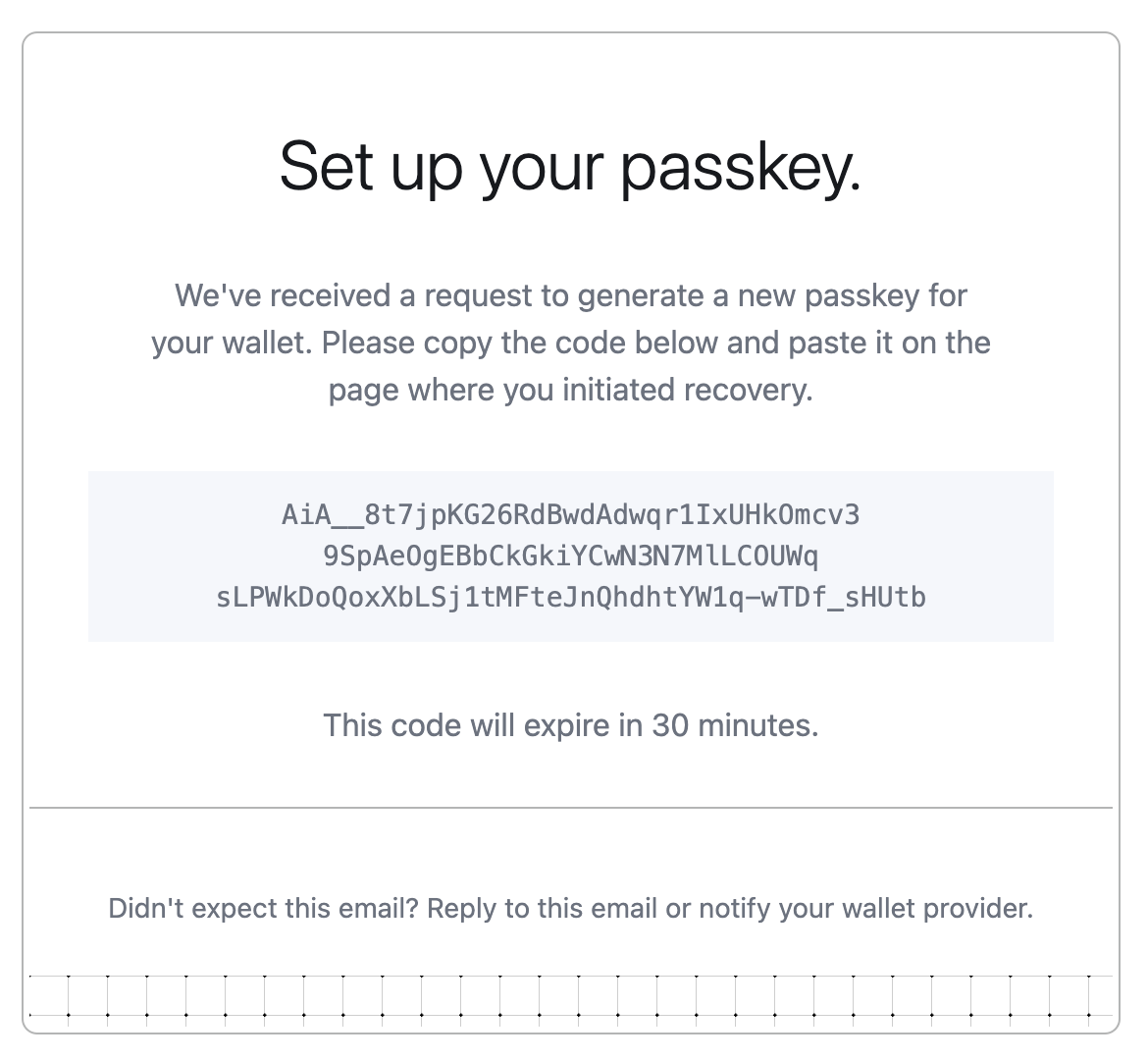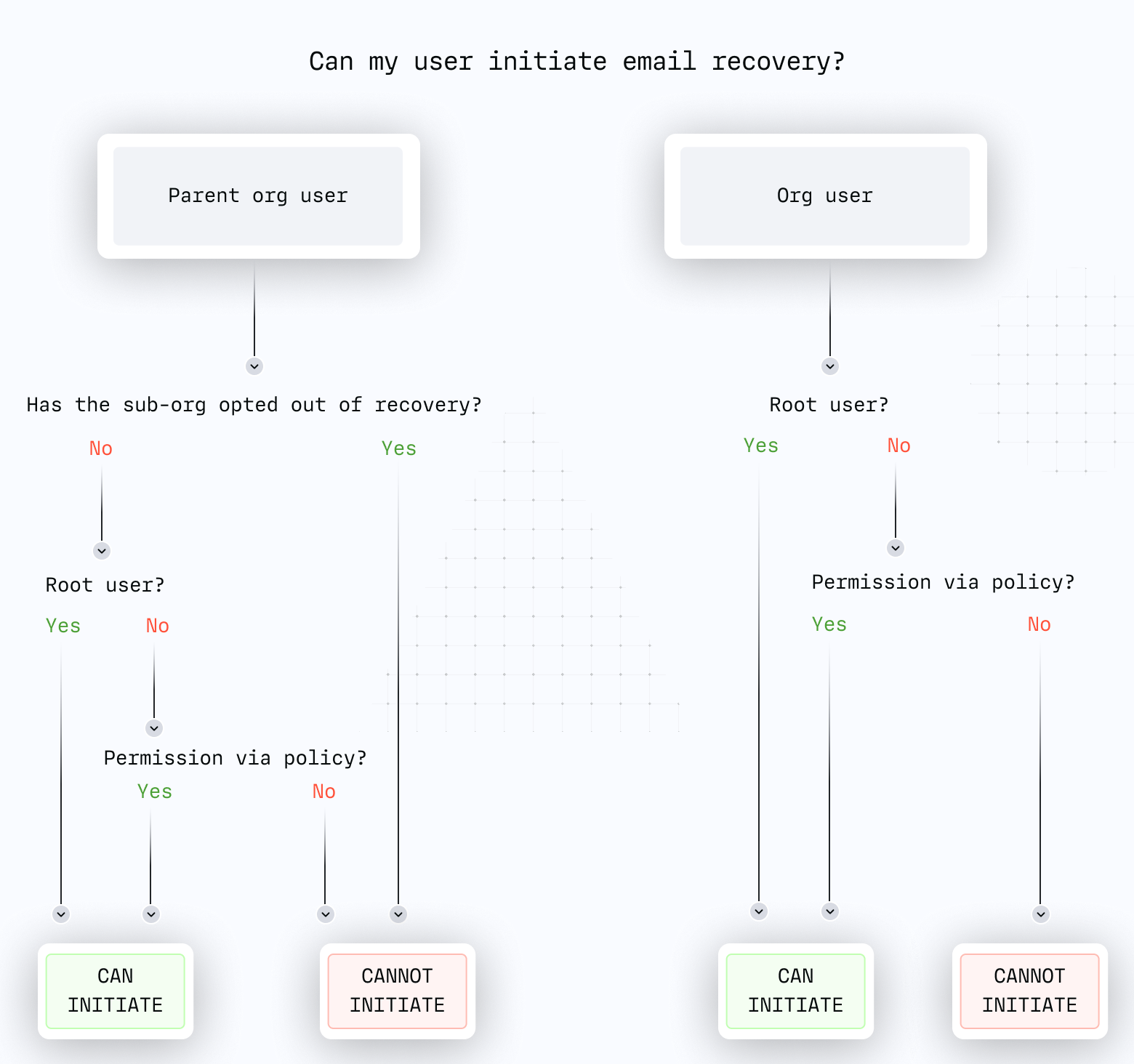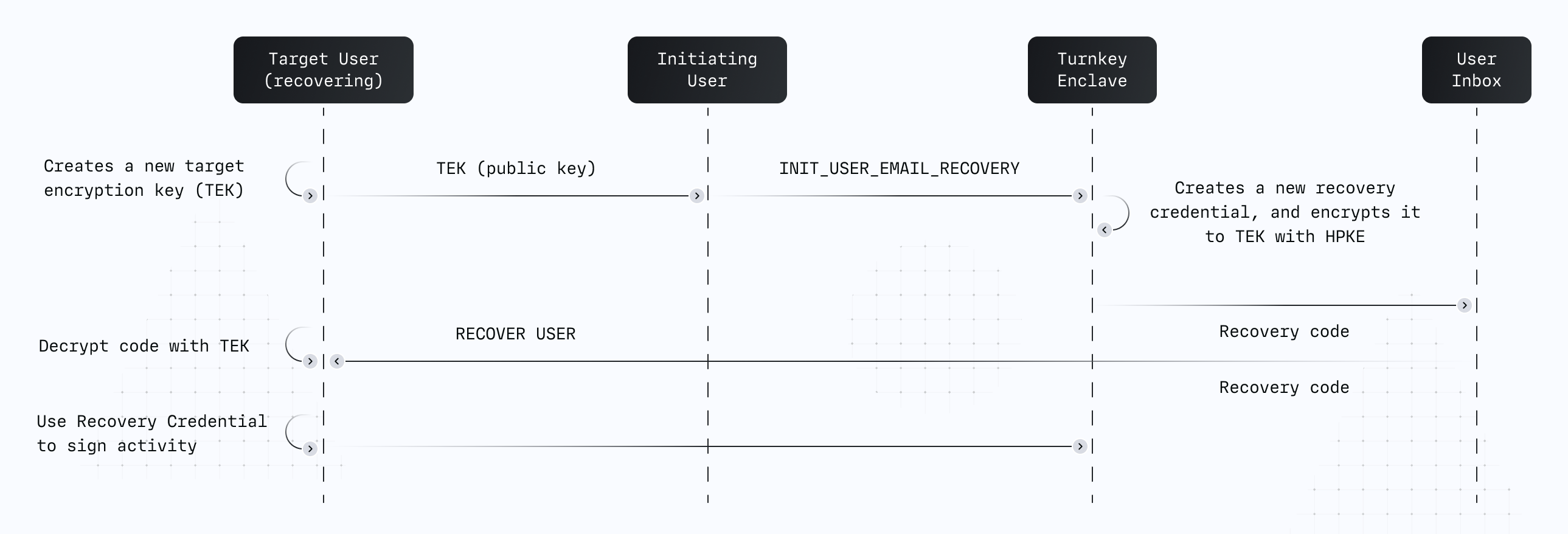Email Recovery
Email Recovery lets a user gain access to their Turnkey account via email in case they've lost access to their API keys and authenticators.
User Experience
This functionality is split in two phases: Initiation and Finalization
Initiation
Email recovery starts with a new activity posted to Turnkey. This activity has the type ACTIVITY_TYPE_INIT_USER_EMAIL_RECOVERY and takes the following as parameters:
email: the email of the user who needs to start recovery. This email must be the email already attached to the user in organization data (i.e., previously approved by the user). This prevents malicious account takeover. If you try to pass a different email address, the activity will fail.targetPublicKey: the public key to which the recovery credential is encrypted (more on this later)
This activity generates a new temporary API key pair (a "recovery credential"), saves the public key in organization data under the target user, and sends an email with the encrypted recovery credential:

Initiating a new email recovery require proper permissions via policies or being a parent organization. See Authorization for more details.
Finalization
Once a user receives a recovery email, recovery credential decryption needs to happen, and the credential can be used to sign a new activity: ACTIVITY_TYPE_RECOVER_USER. This activity accepts a new authenticator in its parameters, and adds this new authenticator to the user. Once this activity completes the user is able to log in using their newly registered authenticator.
Authorization
Authorization for email recovery is based on our usual activity authorization: our policy engine controls who can and cannot execute recovery-related activities.
ACTIVITY_TYPE_INIT_USER_EMAIL_RECOVERYcan be performed by the root user or by any user in an organization if authorized by policy. The activity can target any user in this organization or any sub-organization user. The activity will fail if a parent user tries to initiate recovery for a sub-organization which has opted out of email recovery.ACTIVITY_TYPE_RECOVER_USERshould be signed by the recovery credential sent via email. Even if not explicitly allowed by policy, a user is always able to add credentials to their own user. This includes adding a new authenticator when authenticated with a recovery credential. In other words, no special policy is needed to make this work: users are able to recover out-of-the-box.

Important note: recovery credentials automatically expire after 15 minutes and are overridden when multiple INIT_USER_EMAIL_RECOVERY activities target the same user. Only the most recent recovery credential is valid.
Email recovery in your sub-organizations
Email recovery works well with sub-organizations. Our Demo Passkey Wallet application (https://wallet.tx.xyz) has recovery functionality integrated. We encourage you to try it (and look at the code if you're curious!).
If you're looking for a more concrete guide, head to our Sub-Organization Recovery implementation guide for more details.
Email recovery in your organization
If you want to use email recovery in the context of an organization accessed via our dashboard, we aren't ready yet. This is because we do not have a flow to enroll new passkeys and sign RECOVER_USER activities in our main dashboard.
A workaround if you're a root user trying to perform recovery for one of your users: delete their user and re-invite them by email. It's not perfect because their new user ID will differ from their old one (which means policies might need an update).
If you're a root user and you have lost access to your authenticators, Turnkey cannot perform email recovery for you. You need to create a fresh organization.
Opting out of email recovery
Depending on your threat model it may be unacceptable to rely on email as an authentication factor. We envision this to be the case when an organization has a mature set of root users with multiple authenticators, or when a sub-organization "graduates" from one to many redundant passkeys or API keys. When you're ready, you can disable email recovery with ACTIVITY_TYPE_REMOVE_ORGANIZATION_FEATURE (see Remove Organization Feature). The feature name to remove is FEATURE_NAME_ROOT_USER_EMAIL_RECOVERY.
If you never want to have email recovery enabled, our CREATE_SUB_ORGANIZATION activity takes a disableEmailRecovery boolean in its parameters. Set it to true and the sub-organization will be created without the organization feature.
Cryptographic details
Unlike typical email recovery functionality, Turnkey's email recovery doesn't send unencrypted tokens via emails. This ensures no man-in-the-middle attack can happen: even if the content of the recovery email is leaked, an attacker wouldn't be able to decrypt the recovery credential. The following diagram summarizes the flow:

Our email recovery flow works by anchoring recovery in a target encryption key (TEK). This target encryption key is a standard P-256 key pair and can be created in many ways: completely offline, or online inside of script using the web crypto APIs.
The public part of this key pair is passed as a parameter inside of a signed INIT_USER_EMAIL_RECOVERY activity. The signature on the activity has to come from a user who is authorized to initiate email recovery.
Our enclave creates a fresh P256 key pair ("recovery credential") and encrypts the private key to the recovering user's TEK using the Hybrid Public Key Encryption standard, also known as HPKE or RFC 9180.
Once the encrypted recovery credential is received via email, it's decrypted where the target public key was originally created. The recovery credential is then ready to be used to sign a RECOVER_USER activity, submitted to Turnkey.